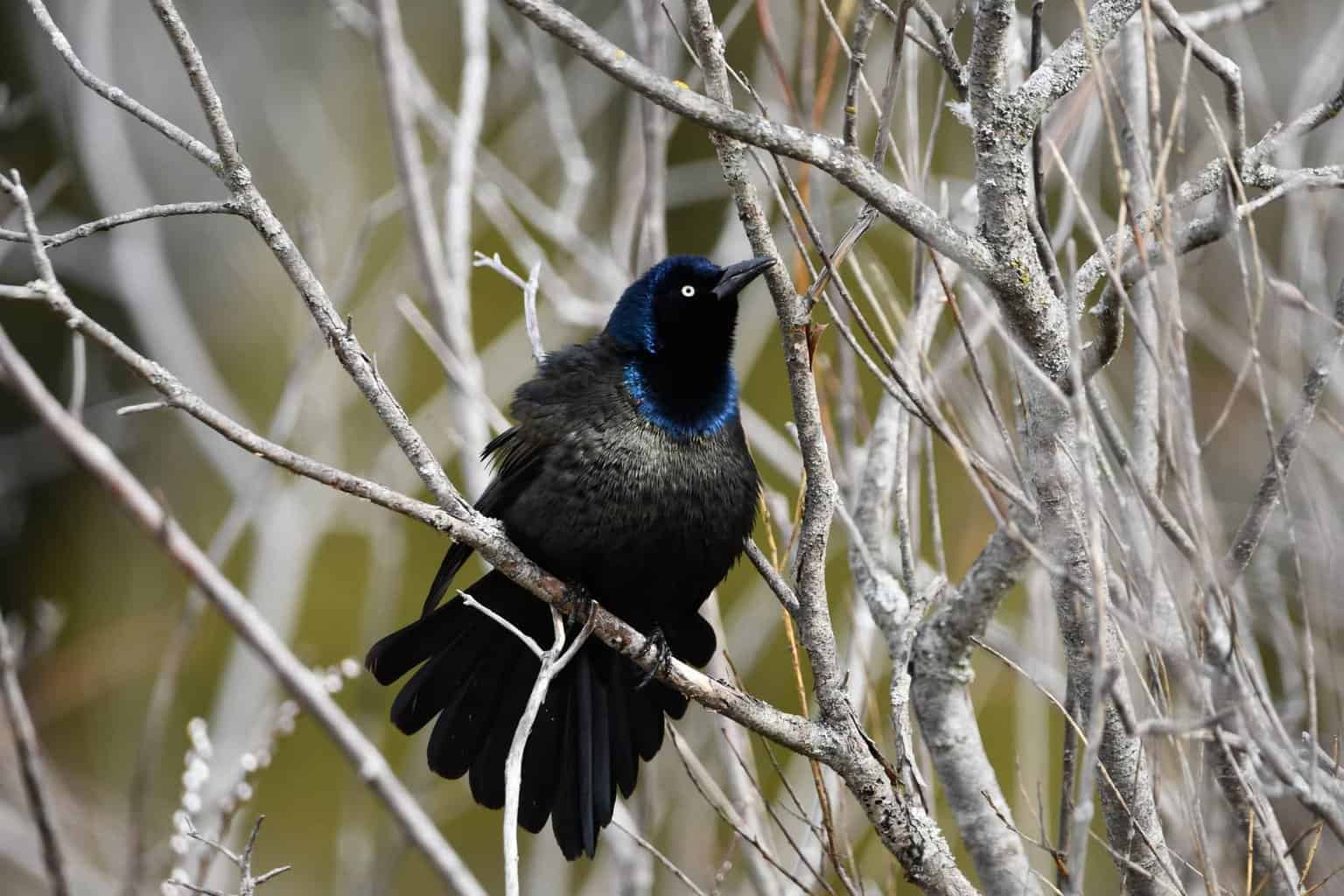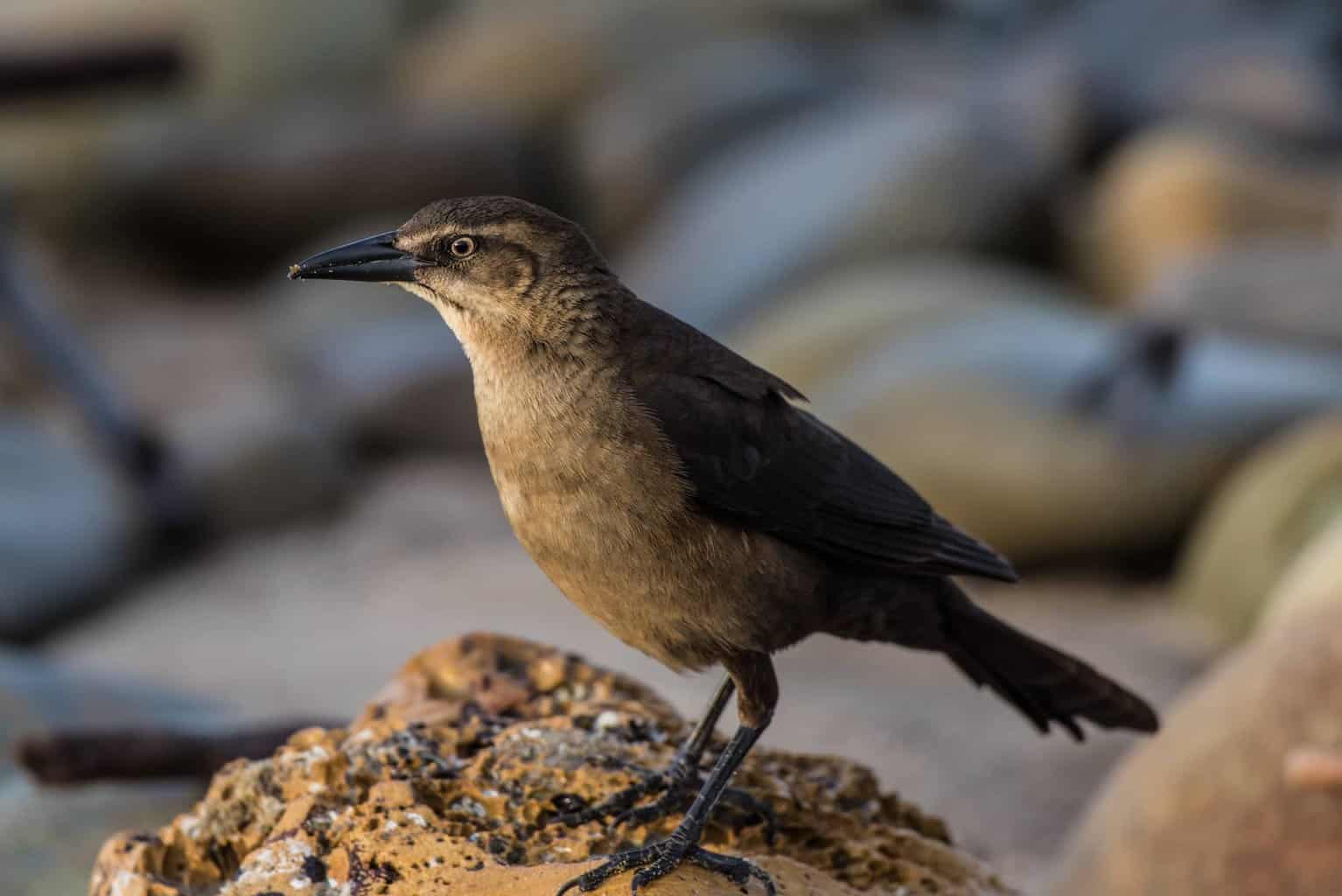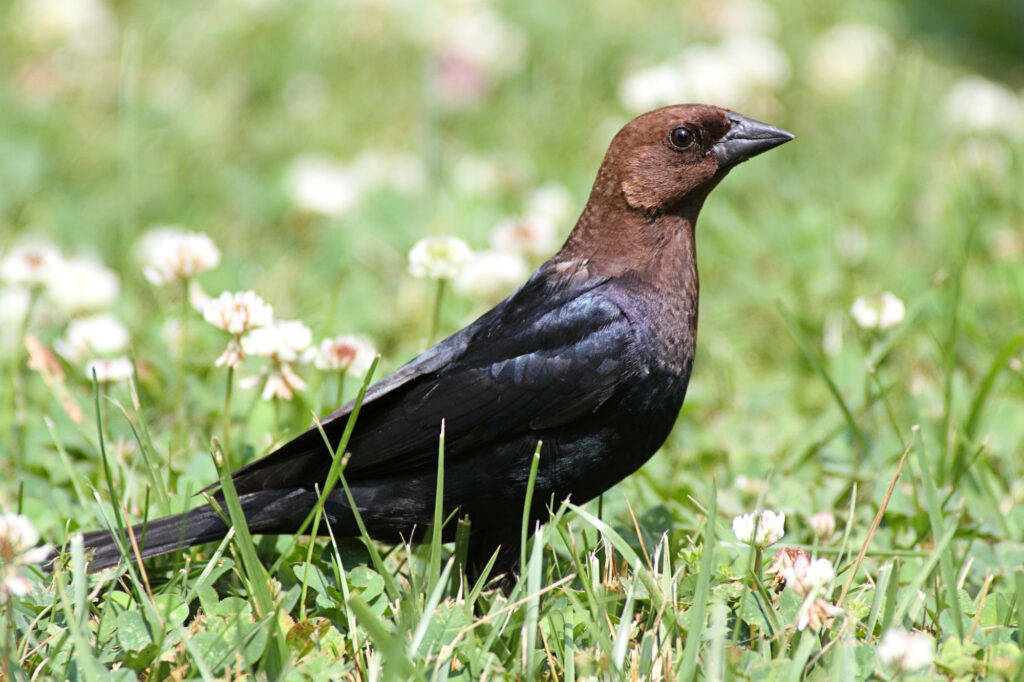Missouri is home to a wide variety of interesting birds. Varying habitats from the Ozarks and the coasts of the Mississippi River to the northern plains and beyond make Missouri an ideal habitat for numerous different bird species.
Some of these birds are new world blackbirds, which make up the blackbird family called Icteridae. Birds like meadowlarks and orioles, while they wouldn’t initially be the birds that come to mind when you hear the term “blackbird,” do belong to that family as well.
Meanwhile, some birds that are black, like starlings and crows, belong to other families.
We’ll focus primarily on blackbirds in the Icteridae blackbird family that you may see in Missouri.
Red-Winged Blackbird

- Scientific name: Agelaius phoeniceus
- Length: 6.7-9.1 inches (all bird length estimates via Cornell Laboratory of Ornithology)
The Red-winged blackbird’s recognizable call fills the air in marshes across Missouri and the entire United States, though you may also find them hanging around farm fields or open meadows.
Male Red-winged blackbirds are identifiable by their red shoulder patches. Females are a bit trickier to identify, as they’re a streaky brown color, which could be confused with other birds such as sparrows.
Yellow-Headed Blackbird

- Scientific name: Xanthocephalus xanthocephalus
- Length: 8.3-10.2 inches
Missouri birdwatchers could see Yellow-headed blackbirds as they head north to northern breeding grounds or travel south for the winter months.
Yellow-headed blackbirds aren’t likely to stick around in Missouri, but you may get lucky and spot one during the spring and fall migration.
Adult males have a vibrant yellow patch on their heads and throat, with black bodies and a distinct white patch on the wing.
Females and juveniles have less distinctive markings, with slightly more dull yellow colorations. The upper parts of female Yellow-headed blackbirds are more brown than black.
The Yellow-headed blackbird’s call is hard to miss if you know what you’re listening for, with a harsh song that some have compared to the rusty edges of a gate.
Like Red-winged blackbirds, you’re most likely to see these birds amongst the reeds and foliage of marshlands, with the occasional spotting in nearby farm fields.
Rusty Blackbird

- Scientific name: Euphagus carolinus
- Length: 8.3-9.8 inches
Rusty blackbirds breed in Canada, but they can sometimes be seen in Missouri, most likely during spring or fall migration. Some may winter in southern Missouri.
Male breeding Rusty blackbirds are black, while breeding female Rusty blackbirds exhibit more of a gray color. Both will display a brown color in the fall.
Though not the only blackbird with yellow eyes, (see Brewer’s blackbird below), the Rusty blackbird’s yellow eyes can certainly help narrow down the identification of these birds.
If you’re lucky enough to spot a Rusty blackbird, it will likely be in a pasture or meadow near wetlands or marshes. Rusty blackbird sightings have become even rarer in recent years as their populations have plummeted.
A 1999 study from the Smithsonian Migratory Bird Center found that Rusty blackbird populations in North America had declined by about 90% in the three decades prior.
Brewer’s Blackbird

- Scientific name: Euphagus cyanocephalus
- Length: 7.9-8.7 inches
Closely related to the Rusty blackbird, Brewer’s blackbirds are rare in Missouri, though you may see one as they pass through the state on their annual migrations.
Males have yellow eyes, while females have brown eyes. Males may exhibit a blue-ish to purple-ish sheen, while females are a more dull brown color.
Common Grackle

- Scientific name: Quiscalus quiscula
- Length: 11-13.4 inches
These common birds are year-round residents of Missouri and can sometimes be considered a nuisance by residents, as they can be noisy and aggressive, and create quite a mess by throwing large amounts of seed off of feeders.
Grackles are bigger than the average blackbird but shorter than crows and with proportionately longer tails.
Males can actually be quite pretty, with shiny blue and purple color plumage presenting itself in good lighting.
Grackles can be seen pretty much anywhere, from open fields and bird feeders in your backyard to marshes and other water sources.
Great-Tailed Grackle

- Scientific name: Quiscalus mexicanus
- Length: 15-18.1 inches
The Great-tailed grackles is a species most common in southern climates, from Mexico and Texas all the way down through Central America.
However, the western edge of Missouri could see Great-tailed grackles on the northeastern tip of their range, and the species has slowly been expanding its range in recent years.
The first record of these grackles in Missouri was in 1976, and they’ve been seen in the state every year since then, according to the Missouri Department of Conservation. Look for them in open areas like marshes and agricultural fields.
Males look similar to common grackles, but with longer tails. Females are brown, with tails that don’t quite stand out as much as their male counterparts.
Brown-Headed Cowbird

- Scientific name: Molothrus after
- Length: 6.3-7.9 inches
Like other birds on this list, the distinct brown head that gives this Brown-headed cowbird its name is only featured on males, which feature a glossy black color throughout the rest of their bodies.
While females do have brown heads, their heads match the rest of their brown bodies, similar to juvenile Brown-headed cowbirds.
These birds with brown heads may be unpopular with backyard birdwatchers, as they are brood parasites. This means that Brown-headed cowbirds lay their eggs in the nests of other birds.
The other species then raise the cowbird’s young. Brood parasites can have negative effects on their host species.
Brown-headed cowbirds are found in farmland and in the woods, often seen looking for food on the ground.
Bobolink

- Scientific name: Dolichonyx oryzivorus
- Length: 5.9-8.3 inches
According to the Missouri Department of Conservation, the bobolink is the only North American bird that has light feathers above and dark feathers below. That alone should help you identify a bobolink if you see one out in the field.
Breeding male bobolinks are mostly black, with white streaks on their wings and tail. The backside of a male bobolink’s head is a paler, almost tan color.
Females, as with many bird species, are a more muted color, with buffy plumage and darker streaks.
Bobolinks are most common in hayfields and meadows. As the United States loses its grasslands, bobolink populations are on the decline.
Struggling To Identify a Black Bird You’ve Seen in Missouri?
If it’s bigger than all the birds on this list, you could be looking at a crow or even a vulture. American crows are common in Missouri, and Fish crows can sometimes be seen along the Mississippi River.
Turkey vultures are also common in Missouri, and black vultures are rarely seen in southern areas of the state.
You could also be looking for a woodpecker or a European starling. Missouri is home to a number of woodpeckers, while starlings have taken over much of North America since their introduction to the continent in the late 1800s.
Orchard and Baltimore’s orioles also have a significant amount of black plumage.
Smaller birds like warblers or towhees sometimes have black colorations, as do grosbeaks and purple martins.

